The Price of Everything, the new HBO documentary from My Architect filmmaker Nathaniel Kahn, is meant to pull back the curtains on the connection between art and money in the contemporary art market from various vantage points, including auctioneers, dealers, advisors, collectors, and artists. Just about 10 years to the day before the release of film, the cantankerous art critic Robert Hughes presented an identically formatted documentary, The Mona Lisa Curse, which surely must have served as a template for Kahn’s documentary. They are uncannily similar, with Kahn’s only lacking the Falstaffian presence of Hughes, who inserted himself as a caustically skeptical character in his film.
According to Hughes’s polemical tirade, the precursor to today’s contemporary market was launched in 1963 when da Vinci’s Mona Lisa embarked on a trip around the United States, like a movie star on a publicity tour, and “people came not to look at it, but to say that they’d seen it.” In The Price of Everything, that ur-moment was pegged to Sotheby’s Ethel and Robert Scull auction in 1973, the first evening sale to feature contemporary art—attaining unprecedented values as a result. In his film, Robert Hughes reduces the present state of the art world to a new “market culture,” while Kahn takes a longer view, saying that art and money have always been in an “uneasy embrace.” They are both off the mark, by miles.
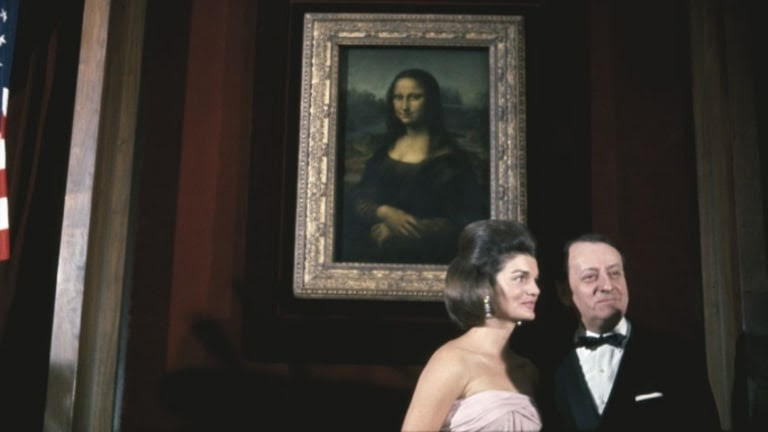
Who’s more attention-grabbing? Political capital on the move, literally. Screengrab courtesy of Kenny Schachter.
I am neither religious nor political, but my back arches like an annoyed cat when confronted with the kind of self-fulfilling, prejudicial, and simplistic points of view presented in both The Mona Lisa Curse and The Price of Everything. Yawn. Art and money have sexed it up for centuries, but rarely sleep in the same bed. Let me explain. Albrecht Dürer (1471-1528) sold editions out of his own shop, employed his mother to assist him in doing so, and shipped copies of his prints ahead of his travels abroad to let his artwork build hype in advance of his arrival. He lamented that the time he spent painting could have been more profitably directed towards printmaking.
As one of the earliest artists to sign paintings, Dürer went to court twice to defend his trademark. (He’d have made a formidable legal adversary had Richard Prince been born 500 years earlier.) Taking matters into his own hands, Rembrandt (1606-1669) did Dürer one better by bidding up his own prints at auction to buttress his prices. Rembrandt was so obsessed with money, according to Svetlana Alpers’s book Rembrandt’s Enterprise, that his assistants painted coins on the studio floor in an effort to get him to bend over and try to pocket them. But still, as the most mercenary taking heads in both Kahn and Hughes’s films repeat again and again, art is art and nothing can change or dilute it. At its core, art is impervious to money—even when it’s an underlying component in its making.
It’s true that the contemporary art spectacle as we know it today, from lottery-sized painting payouts to artists’ celebrity branding exercises, may have incubated in the 1960s or ’70s, but then things went quiet for nearly 25 years, until a confluence of over-the-top events in the latter half of 1990s. Please pardon my flippancy, but I reckon Dr. Bernardo Nadal-Ginard, a Boston cardiologist who went to jail for embezzling money from a children’s heart fund to collect contemporary art, to be among our greatest collectors. He had to have the art of the moment—by Kiki Smith, Jeff Koons, Matthew Barney, and Robert Gober, among other major artists—no matter the cost, with incarceration for his abominable moral transgression being just one. During the forced sale of his collection at Sotheby’s in 1997, inserting recently made works in to an evening auction, records fell one after the other, including the $250,000 sale of a Jeff Koons on an estimate of $125,000 to $175,000. Sixteen short years later, Koons’s record would rise to $58.4 million.
Forget the speed of sound—one should measure the speed of money.
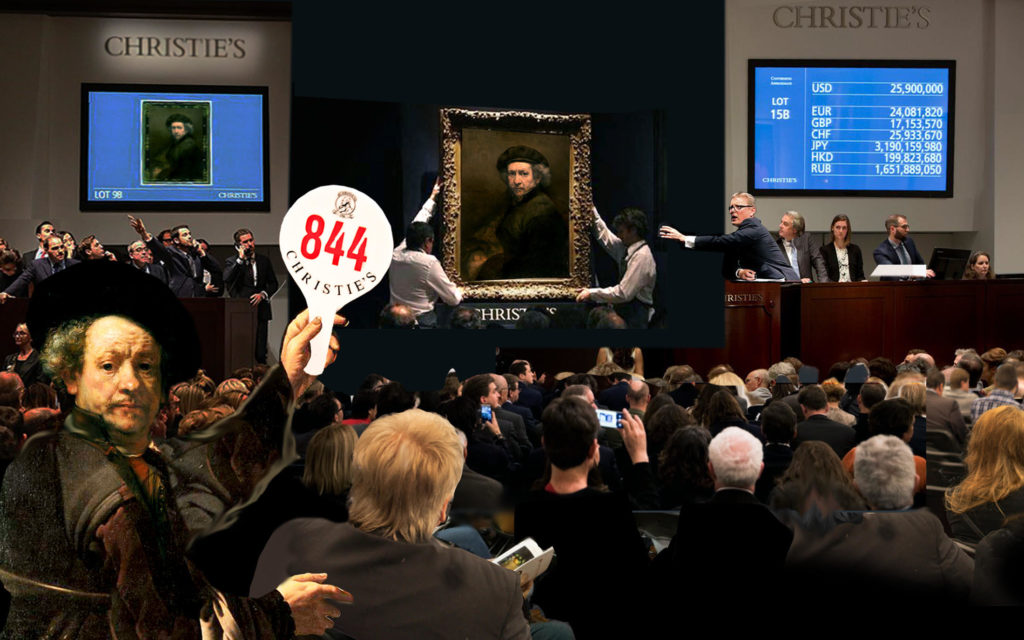
Same old, same old—some things never change. Nice painting, I’ll have that! Photo illustration courtesy of Kenny Schachter.
A year later, in 1998, Christie’s launched its first evening sale built by a newly formed department focusing on work created since 1970 in an attempt to attract new, younger buyers. Every single artwork in the sale sold, producing 12 record prices for the likes of Gerhard Richter, Sigmar Polke, and Dan Flavin and totaling $16.2 million—above enough the sale’s $12.6 million high estimate to usher in the dawn of a new art market. By the way, the record for a single auction stands at $852.9 million at Christie’s in 2014—not bad for just about an hour’s work. (Yet the way they were throwing money around with in-house guarantees, I am all but certain they still managed to lose a shitload of money on the sale.)
Now, jump ahead to September 11, 2001. As the world recoiled after the World Trade Center attack, fundamental shifts took place in the mindset of the public, including the biggest players in the collecting universe. A hyper-charged focus on the interconnectedness of global politics and the inescapable relevance of current events coincided with an inward turn to family and the home in the face of unprecedented uncertainty, instability, and vulnerability. It was a new world, and as a result, attention shifted dramatically to the new. I have a friend, a former major success story in the antiques trade. From one day to the next his business evaporated; to this day, there’s no recovery in sight.
In the process, tastes were radically refashioned, and values for contemporary art steadily increased (and not just because “classic” older stock was drying up). The art market has now expanded more in the past 50 years than it had in the previous 500. Younger people respond more to their contemporaries in every corner of life and, as wealth gets passed from generation to generation like a baton in a relay race, resources have been increasingly funneled to the here and now—at the same moment as artists have been elevated to the status of high-flying hybrid entertainer-designer-wealth generators. The democratizing forces of the internet have only fueled the exodus to contemporary.
But back to The Price of Everything. (I didn’t forget.) There have been many reviews to date, and I don’t want to dwell on the details, especially the negatives, of which there are plenty. So here’s a smattering of observations on both sides. I like and admire Amy Cappellazzo—she’s bright and has become rich from her own druthers, and that’s admirable, so hats off. But at times, in the film, she comes off sounding like a car crash between The Sopranos and Curtis James Jackson III, known professionally as 50 Cent, like when she uses the word “hundo” to refer to $100 million—a bit of slang I had to confirm with my kids. She also remarked that good art makes itself known regardless of value, even to lay audiences, and I wholeheartedly concur.
Another “collector” blabs about being a rich person on Park Avenue writing journalism and novels about incredibly insecure and neurotic rich people living on Park Avenue. Fascinating. She’s an avowed art lover who has some free money to spend at auction from having sold off some other art she previously (allegedly) cared for, also at auction. Can’t add much more to that.
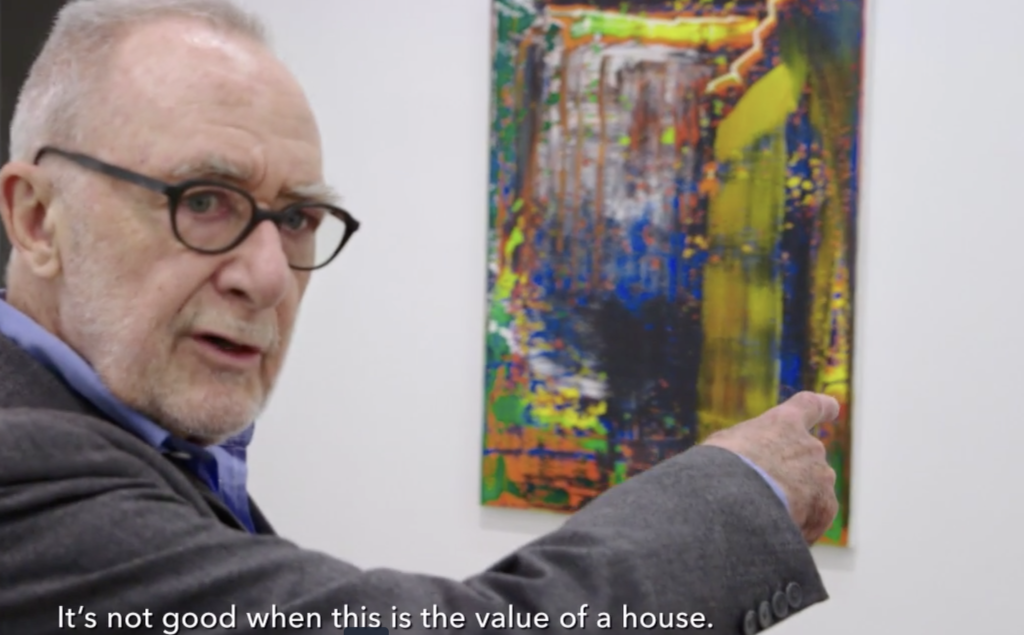
Grrr-hard… then lower your prices, dude. Screengrab courtesy of Kenny Schachter.
A titan of art at 86 years old, Gerhard Richter is hard to criticize, but it’s also hard to take when he snarls that “it’s not good when this”—pointing at his latest squeegee painting—”is the value of a house.” He follows this fit of pique with a comment that only a casually privileged person in a position of great wealth could make: “Money is dirty.” Gerhard, I have a few questions, if I may. Why shouldn’t a painting sell for the value of a house if it’s good? And, if you don’t like foisting such an onerous choice on prospective homeowners, then why not lower your prices? Is Marian Goodman that much of a bully, a threat?
That brings me to Jeff Koons. I wish he wouldn’t, but whenever he speaks about his art (as he does all too often) I have utterly no clue what he’s trying to say—the self-helpy, pseudo-self-actualized blather is enough to make me convulse. But, in one of his many appearances in the film, I could finally understand what he was getting at when he began imitating the sounds of his proposed $50 million steam-engine sculpture, puffing and tooting and woo-woo-wooing in a way that unsurprisingly bordered on the disturbing. His assistants must have been bewildered, and it’s worth sitting through the 1 hour and 38 minutes of the documentary just for that. I know, I watched it twice.
One last point in the realm of the negative. The advisor, lecturer, DJ, artist, and, of course, world-famous auctioneer Simon de Pury, who I count as a friend (we are of the same ilk, if only for our shared overabundance of job descriptions), said something that made my skin crawl, with all due respect—that “it’s important for good art to be expensive, because you only care and protect things with a high value.” If that woefully misguided notion were ever to have taken hold, which it hasn’t, we’d be left with nothing more than the market art of the moment. No thanks.
Moving to the positive, the Chicago collectors Stefan Edlis and Gael Neeson and the artist’s artist (translate: not selling much at the moment) Larry Poons steal the show, emerging as undisputed stars who undoubtedly could have carried the whole shebang on their own. Edlis is so forthright, frank, and unusual a character, he comes off as nothing less than adorable. I fell for him.
When Edlis relates stories about Hitler—whose name he couldn’t bring himself to mouth, having barely evaded the camps—I teared up. Wow. He donated a chunk of his art (approaching $500 million worth) to the Art Institute of Chicago for no other reason than “it makes you feel like you have done something with your life.” By his own admission, he owns obvious art by obvious suspects, and covets owning the thing-in-itself—but then again, he readily gave it away.
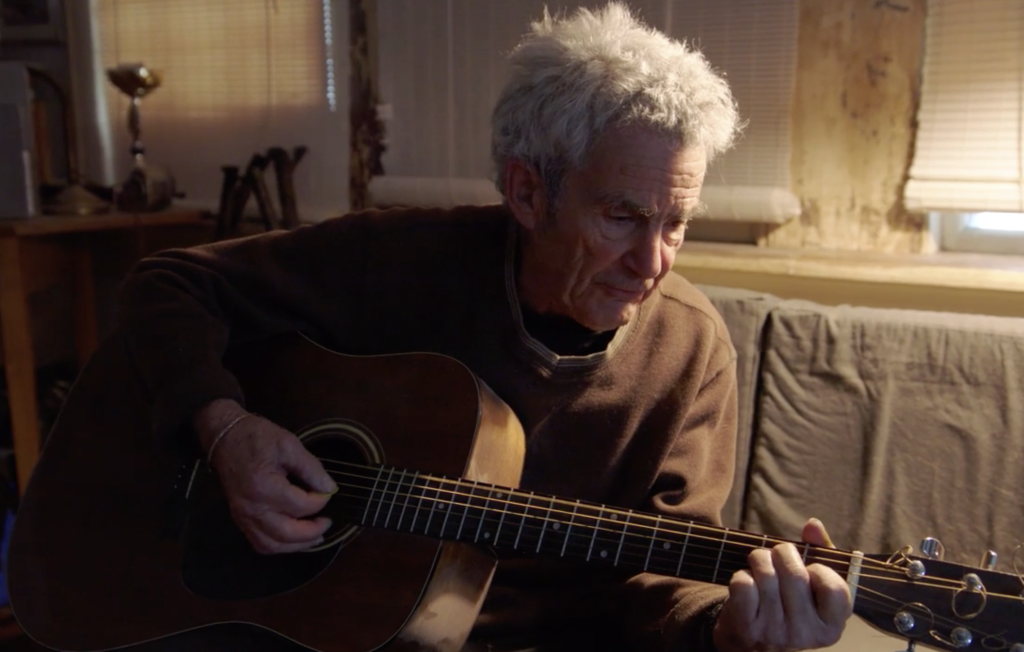 I generally do not respond well to magic, but watching a painter paint—in this case the 81-year-old Poons, working away in his upstate New York bolt-hole—is mesmeric and wondrous. Says Poons—long forgotten, and, in his own words, written off as dead—“My only defense against fate is color.” If that isn’t the cutest thing, then watching him paint in his studio, tool around on a racing motorcycle, and sing ballads on a beaten-up old guitar surely is. He seems to be in a constant state of eye-rolling annoyance at the world for not being up to speed.
I generally do not respond well to magic, but watching a painter paint—in this case the 81-year-old Poons, working away in his upstate New York bolt-hole—is mesmeric and wondrous. Says Poons—long forgotten, and, in his own words, written off as dead—“My only defense against fate is color.” If that isn’t the cutest thing, then watching him paint in his studio, tool around on a racing motorcycle, and sing ballads on a beaten-up old guitar surely is. He seems to be in a constant state of eye-rolling annoyance at the world for not being up to speed.
A onetime market darling who showed with Leo Castelli in the 1960s, Poons plays his allotted role in the documentary as the undervalued and underappreciated wayward soul, saying, “There’s no intrinsic hookup between art and money.” Not his, anyway. But priced from $50,000 to a few hundred thousand dollars, Poons’s softly colorful, lyrical abstractions in the vein of Joan Mitchell may soon fly after all. When I posted a picture of him on his motored steed on Instagram, a secondary dealer kindly asked if I wanted a 1960s work for a million-plus. Ah, the affirmation of media’s warming glow…
Gavin Brown says in the documentary that art and money are like Siamese twins, and that “the purpose of art has been perverted and mutated, and art is finding a hard way out of it.” He also says that “art is careening to an edge or end—I can smell the smoke!” Nah, there’s no need to be so alarmist. There are more fear-mongers abounding than ever before, but I only smell more of the same.
The Price of Everything touches upon some salient points about our art lives, but they are far afield from the price of anything. That said, there is extraordinary material in the documentary, priceless (see what I did there?) footage of Poons at work and Edlis reminiscing about his acquisitions as he is giving them away. It’s a truism that some of the biggest assholes in the art world are among the most knowledgeable, but the only takeaway from The Price of Everything is that nothing holds a candle to fortitude and passion.
One last point. Cash as we know it today came into existence during the Tang Dynasty (A.D. 618-907), possibly to facilitate the Emperor’s burgeoning fine art collection. With the advent of today’s technological advances, from 3D and AI to new forms of money itself, what’s next for art is anyone’s guess—but I assure you I’ll want it, and I’ll want to be associated with it.
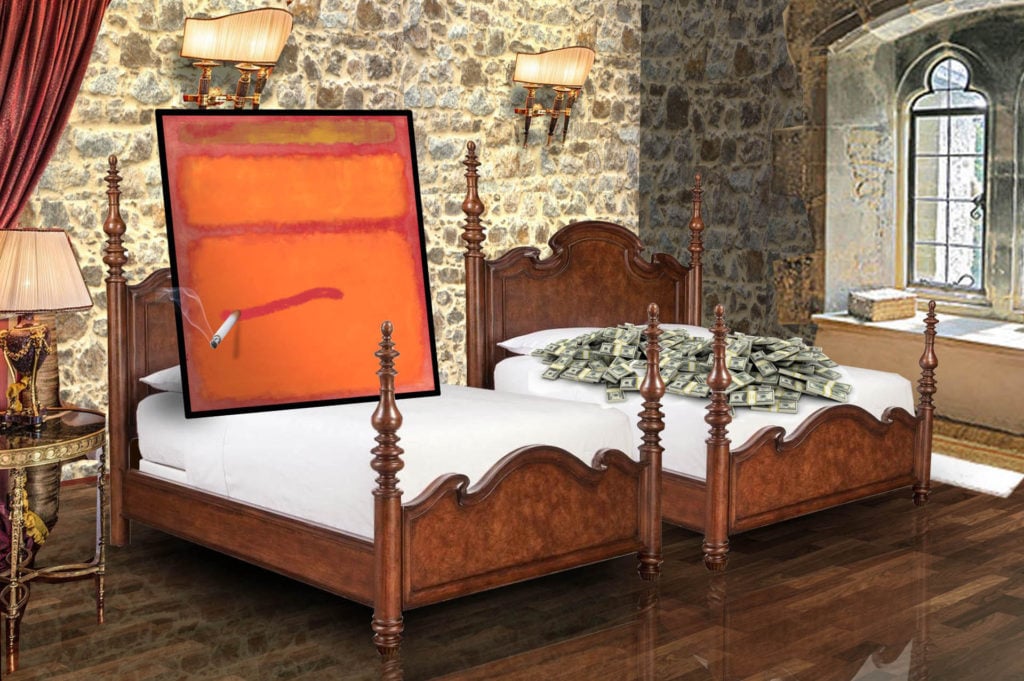




 I generally do not respond well to magic, but watching a painter paint—in this case the 81-year-old Poons, working away in his upstate New York bolt-hole—is mesmeric and wondrous. Says Poons—long forgotten, and, in his own words, written off as dead—“My only defense against fate is color.” If that isn’t the cutest thing, then watching him paint in his studio, tool around on a racing motorcycle, and sing ballads on a beaten-up old guitar surely is. He seems to be in a constant state of eye-rolling annoyance at the world for not being up to speed.
I generally do not respond well to magic, but watching a painter paint—in this case the 81-year-old Poons, working away in his upstate New York bolt-hole—is mesmeric and wondrous. Says Poons—long forgotten, and, in his own words, written off as dead—“My only defense against fate is color.” If that isn’t the cutest thing, then watching him paint in his studio, tool around on a racing motorcycle, and sing ballads on a beaten-up old guitar surely is. He seems to be in a constant state of eye-rolling annoyance at the world for not being up to speed.



